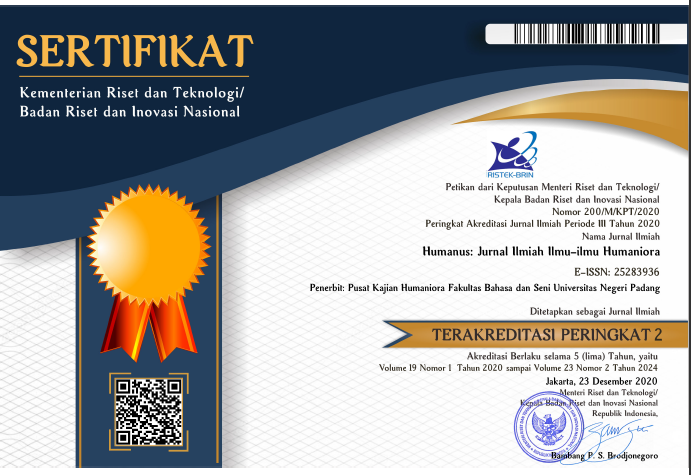Multimodalities Element In The Cartoon Work Through Linguistic Modes And Visual Modes
 ), Zulkifli Osman(3), Husna Faredza Mohamed(4), Mazura Mastura Muhammad(5), Marlini Idris(6),
), Zulkifli Osman(3), Husna Faredza Mohamed(4), Mazura Mastura Muhammad(5), Marlini Idris(6), (1) Fakulti Bahasa dan Komunikasi Universiti Pendidikan Sultan Idris 35900 Tg. Malim, Perak Darul Ridzuan
(2) Jabatan Bahasa dan Kesusasteraan Melayu Fakulti Bahasa dan Komunikasi 35900 Tg. Malim Perak
(3) Fakulti Bahasa dan Komunikasi Universiti Pendidikan Sultan Idris 35900 Tg. Malim, Perak Darul Ridzuan
(4) Fakulti Bahasa dan Komunikasi Universiti Pendidikan Sultan Idris 35900 Tg. Malim, Perak Darul Ridzuan
(5) Fakulti Bahasa dan Komunikasi Universiti Pendidikan Sultan Idris 35900 Tg. Malim, Perak Darul Ridzuan
(6) Pusat Pengajian Bahasa Umum Universiti Pendidikan Sultan Idris 35900 Tg. Malim, Perak Darul Ridzuan
 Corresponding Author
Corresponding Author
Copyright (c) 2020 Humanus
DOI : https://doi.org/10.24036/humanus.v19i2.109103
Full Text:
 Language : en
Language : en
Abstract
Keywords
References
Bahrani, T. & Soltani, R. (2011). The Pedagogical Values of Cartoons. Research on Humanities and Social Sciences. 1(4): 19-22.
Bezemer, J. and Jewitt, C. (2010). Multimodal Analysis: Key Issues. Research Methods in Linguistics. London: Continuum.
Conners, J. L. (2010). Barack Versus Hillary: Race, Gender, and Political Cartoon Imagery of the 2008 Presidential Primaries. American Behavioral Scientist. 54(3): 298-312.
Goddard, Angela (2002). The Language of Advertising: Written Texts. London: Routledge.
Halliday, M.A.K. (1994). An Introduction to Functional Grammar. Second Edition. London: Edward Arnold.
Halliday, M.A.K. and Webster,J.J (2009). The Essential Halliday. London and New York: Continuum.
Halliday, M.A.K. and Matthiessen, C. (2004). An Introduction to Functional Grammar. Third Edition. London: Edward Arnold.
Hanita Hassan. (2012) Multimodal Communication of Corporate Website Design. Skudai: UTM Press.
Mohamed Redzwan, H. F., Bahari, K. A., Sarudin, A., & Osman, Z. (2020). Strategi pengukuran upaya berbahasa menerusi kesantunan berbahasa sebagai indikator profesionalisme guru pelatih berasaskan skala morfofonetik, sosiolinguistik dan sosiopragmatik. Malaysian Journal of Learning & Instruction, 17(1),187-228.
Jewitt, C (2008). Multimodality and Literacy in School Classrooms. Sage Journals, Review of Research in Education. 32(1): 241-267
Jewitt, C (ed) (2014). The Routledge Handbook of Multimodal Analysis. London: Routledge.
Kress, G. and van Leeuwen, T. (1996, 2006). Reading Image- The Grammar of Visual Design. London: Routledge.
Kress, G. and van Leeuwen, T. (2001). The Modes and Media of Contemporary Communications. London: Arnold.
Jewitt, C, Kress, G, Ogborn, J and Tsatsarelis,C. (2010). Exploring Learning Through Visual, Actional and Linguistic Communication: The Multimodal Environment Of A Science Classroom, Educational Review, 53(1): 5-18.
Kress, G. (2014). ‘What is mode?.’ In Jewitt, C (ed) (2014). The Routledge Handbook of Multimodal Analysis. London: Routledge: pp 60-75.
Mitchell, W.J.T (2006). What Do Pictures Want?: The Lives and Loves of Images. Chicago and London: University of Chicago Press.
Mohd Majid Konting (2005). Kaedah Penyelidikan Pendidikan. Kuala Lumpur: Dewan Bahasa dan Pustaka.
Mohd Yuszaidy dan Muammar Ghaddaffi (2015). Impak Media Baharu Terhadap Sistem Nilai Masyarakat Melayu di Malaysia. Jurnal Komunikasi, 31(2): 33-46.
Puteri Roslina Abdul Wahid (2003). Pendekatan Sosiokognitif Dalam Seni Kartun: Kajian Kes Kartun Lat. Jurnal Bahasa, 3(3): 433-456.
Rohani Embong, Hanita Hassan dan Noor Aireen Ibrahim(2016). The Representations Of Leadership by Example In Editorial Cartoons. Jurnal Komunikasi. 32(1): 625-650.
Sani, I., Abdullah, M.H., Ali, A.M. dan Abdullah, F.S (2012). The Role of Humor in the Construction of Satire in Nigerian Political Cartoons. Online Journal of Communication And Media Technologies, 2(3): 148-165.
Sarudin, A., Mohamed Redzwan, H. F., Osman, Z., Raja Ma’amor Shah, R. N. F., & Mohd Ariff Albakri, I. S. (2019a). Menangani kekaburan kemahiran prosedur dan terminologi awal Matematik: Pendekatan leksis berdasarkan Teori Prosodi Semantik. Malaysian Journal of Learning and Instruction, 16(2), 255-294.
Sarudin, A., Mohamed Redzwan, H. F, Osman, Z., & Mohd Ariff Al-Bakry, I. S. (2019b). Using the Cognitive Research Trust scale to assess the implementation of the elements of higher-order thinking skills in Malay Language teaching and learning .International Journal of Recent Technology and Engineering(IJRTE,), 8(2S2), 392-398.
Stoian, C.E. (2013). Tourism and Technology: A Multimodal Analysis of Online Heritage Promotion. Professional Communication and Translation Studies, 6(12): 109-118.
Tatabahasa Dewan, Edisi Ketiga, (2008). Kuala Lumpur: Dewan Bahasa dan Pustaka.
Van Leeuwen, T. (2008). Discourse and Practice: New Tools for Critical Discourse Analysis. Oxford: Oxford University Press.
Zuraini Ramli (2016). Kepelbagaian Modaliti Dalam Pengajaran dan Pembelajaran Dwibahasa. Pendeta Journal of Malay Language, Education and Literature, 7, 156-169.
O’Halloran,K.A.(ed). (2006) English Grammar in Context. Book 2: Getting inside English. The Open University.
Osman, Z., Sarudin, A., Abdul, A. H., & Ayob, R. (2019). Teachers’ Understanding and the Level of Implementation of Authentic Elements in the Teaching of Malay Language Writing and Their Relationships with School Type, Teachers’ Experience, and Specialization. International Journal Academic Research Business and Social Sciences, 9(1), 1245–1256.
 Article Metrics
Article Metrics
 Abstract Views : 465 times
Abstract Views : 465 times
 PDF Downloaded : 198 times
PDF Downloaded : 198 times
Refbacks
- There are currently no refbacks.
Copyright (c) 2020 Humanus

This work is licensed under a Creative Commons Attribution-NonCommercial 4.0 International License.










